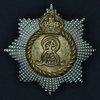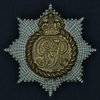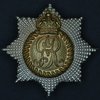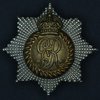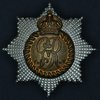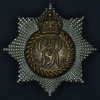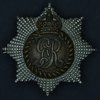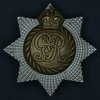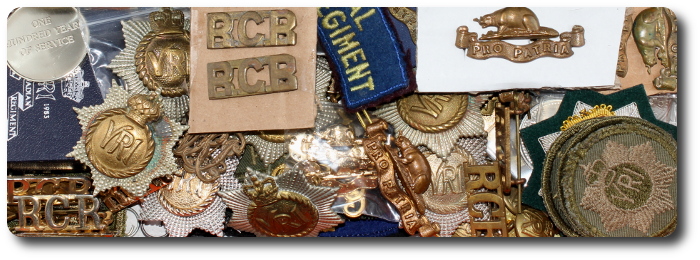
Badges of The Royal Canadian Regiment
1911 - 1919
The King George V Badges of The RCR
Notes and References
1911
General Order 26, March 1911
1. The Royal Cypher of His Majesty King George (G.R.V.) will supercede the Royal Cypher E.R.VII, which has hitherto been in use for regimental buttons and other dress and equipment purposes.
G.O. 146 of 1901 will be considered to be cancelled in this respect.
(H.Q. 1-1-8)
(as presented in The RCR Museum Archives document 14-3076-1894/930)
The RCR wore badges with the King's crown and the cypher of His Majesty King George V from his ascension to the throne in 1911 until 1919, when the Regiment was authorized to wear the Royal Cypher of Queen Victoria.
The premiere collector's reference for badges of the Canadian Expeditionary Force of the First World War is Cap Badges of the Canadian Expeditionary Forces 1914-1919 by Lenard L. Babin. As the following illustration shows, Babin's diagrams provide a general reference for regimental badges, but do not offer sufficient detail to distinguish variations beyond major style changes for some badges of the CEF battalions. Babin's work as a principal reference for CEF badges is primarily based on the common use of his numbering system to reference CEF badges.
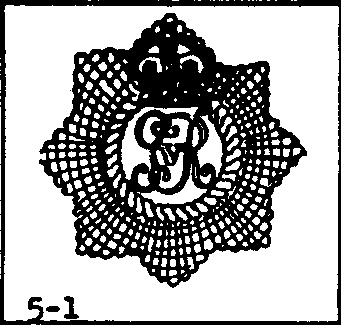
1913
“At the time of the German warship's [Huerta] visit [1 October 1913], consideration was being given to the Regiment's badges. The designs bearing the V.R.I. cypher of Her Majesty Queen Victoria were still in use in some instances, but had been replaced in others by types bearing the cypher of His Majesty King Edward VII or that of His Majesty King George V. A number of designs were submitted to Lieut.-Col. Fages, but no decision was reached until, as mentioned later in this book, the point was eventually settled by the restoration to the Regiment of the right to use the V .R.I., "in memory of the Sovereign in whose reign the unit was raised and in view of the services the Regiment rendered in the Great War.” - (pp. 193, The Royal Canadian Regiment; 1883-1983, R.C. Fetherstonaugh,1936)
1913
(Reproduced from a letter by Mr. Dudley Spencer, published in Pro Patria #24, May 1975.)
"I plainly recall some sixty two years ago, when cleaning our scarlet uniforms, some badges were ER VII, some were GRV on the shoulder straps and cap badge. VRI Emblems were very scarce, but the battle continued for the granting of all ranks to wear VRI badges and buttons. It was through the hard work of Colonel EA Lesley Smith and Major HT Cock, MC, that Royalty and the Canadian Government finally granted permanently the VRI Insignia for The Regiment to wear. "
477869, Dudley Douglas Spencer - http://data2.archives.ca/cef/gat3/113342a.gif
1915
Immediately after settling down in Quested Farm Camp [Sept 1915], the unit began musketry, bombing, and other training for service in France. …. At this time the Battalion received its horses and transport wagons; all badges of brass were bronzed; an "R.C.R.” shoulder badge was substituted for the familiar "V.R.I."; and extensive changes in the appointments held by officers were effected. Somewhat later, each man was given a C.E.F. number in place of his Permanent Force number, the block allotted running from 477,000 to 478,000; ….. - (pp. 212, The Royal Canadian Regiment; 1883-1983, R.C. Fetherstonaugh,1936)
Then, upon the death of Queen Victoria, His Majesty King Edward VII, in accordance with the custom in such circumstances, granted permission for the Regiment to wear his cypher. As the Regiment, however, wished to retain the V.R.I. in honour of the late Queen, a prolonged correspondence between the unit and Militia Headquarters followed, ending after eight years when Headquarters ruled that "this correspondence must now cease. "Officers at the time were still wearing V.R.I. badges in some instances, but E.R.I. badges had been issued to the men. Later E. R. VII and still later G. R. V badges and buttons were issued."
In 1912, the matter was referred to the College of Heralds and, upon the receipt of this body's opinion, Lieut.-Col. A. O. Fages, then Officer Commanding the Regiment, called for new designs. A number of drawings were accordingly submitted, but as all failed to meet the need, Militia Headquarters refused to authorize them. So matters stood in 1914 when the Great War intervened. - (pp. 212, The Royal Canadian Regiment; 1883-1983, R.C. Fetherstonaugh,1936)
- The O'Leary Collection; Medals of The Royal Canadian Regiment.
- Researching Canadian Soldiers of the First World War
- Researching The Royal Canadian Regiment
- The RCR in the First World War
- Badges of The RCR
- The Senior Subaltern
- The Minute Book (blog)
- Rogue Papers
- Tactical Primers
- The Regimental Library
- Battle Honours
- Perpetuation of the CEF
- A Miscellany
- Quotes
- The Frontenac Times
- Site Map
QUICK LINKS
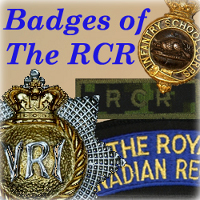
1. Introduction
2. Crowns, Cyphers and Controversy
3. Rare and Unusual Regimental Badges
4. Shoulder Flashes and Titles
1883
1894-1902, 1919-27
South African War
EviiR Badges (1902-11)
GvR Badges (1911-19)
St Edward's Crowns (1927-70s)
Maj Cock, M.C., Collection (1933)
Imperial Crowns (1926-50s)
Imperial Crowns (1960s-80s)
Dress Regs - 1960
Dress Regs - 1967
1980s
1990s
2000+
Woven Badges
Blazer Badges
Pipers' Badges
Belt Buckles
Miscellaneous
Crowns, Cyphers and Stars
RCR Headdress
Badged Brodies
Badge References
